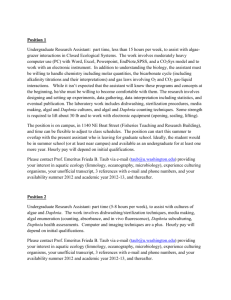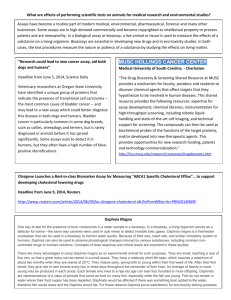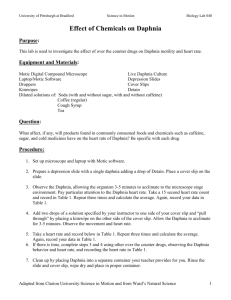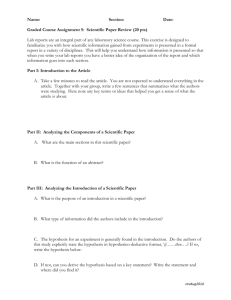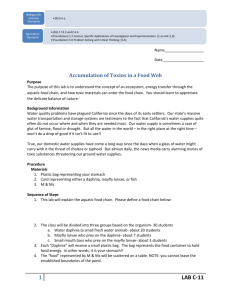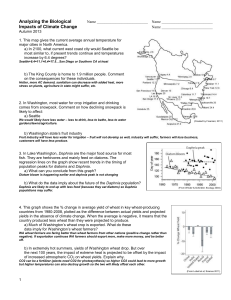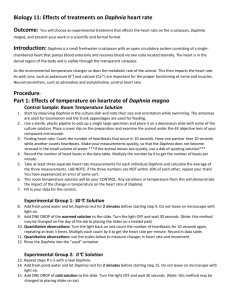Daphnia writeup - Brandeis University
advertisement
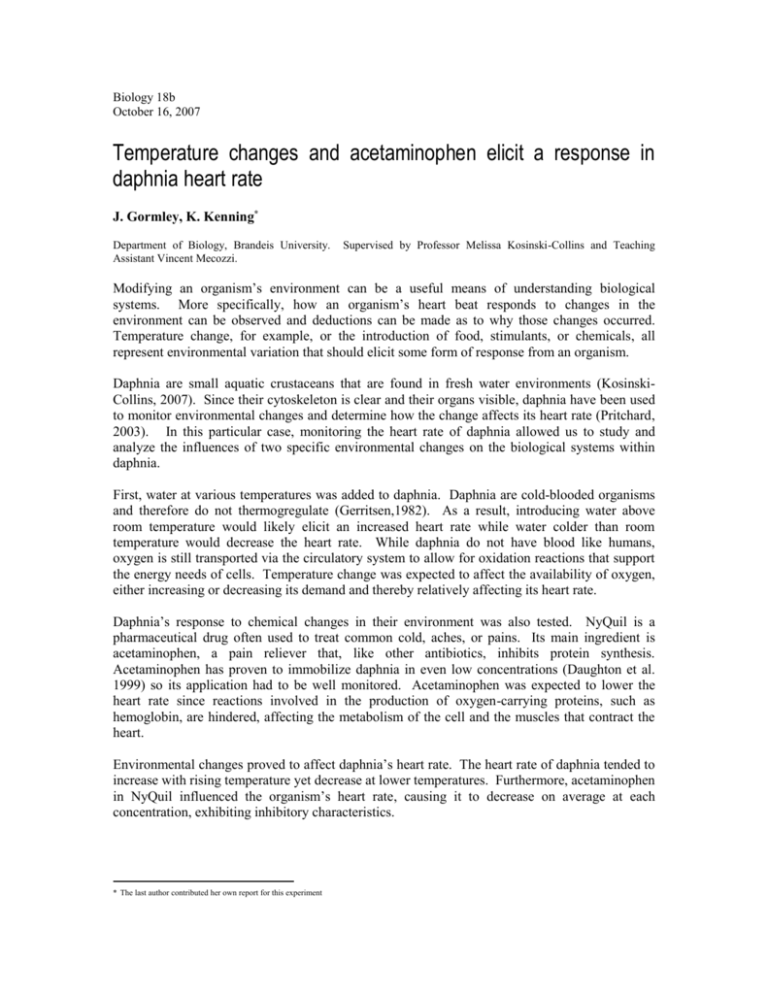
Biology 18b October 16, 2007 Temperature changes and acetaminophen elicit a response in daphnia heart rate J. Gormley, K. Kenning* Department of Biology, Brandeis University. Assistant Vincent Mecozzi. Supervised by Professor Melissa Kosinski-Collins and Teaching Modifying an organism’s environment can be a useful means of understanding biological systems. More specifically, how an organism’s heart beat responds to changes in the environment can be observed and deductions can be made as to why those changes occurred. Temperature change, for example, or the introduction of food, stimulants, or chemicals, all represent environmental variation that should elicit some form of response from an organism. Daphnia are small aquatic crustaceans that are found in fresh water environments (KosinskiCollins, 2007). Since their cytoskeleton is clear and their organs visible, daphnia have been used to monitor environmental changes and determine how the change affects its heart rate (Pritchard, 2003). In this particular case, monitoring the heart rate of daphnia allowed us to study and analyze the influences of two specific environmental changes on the biological systems within daphnia. First, water at various temperatures was added to daphnia. Daphnia are cold-blooded organisms and therefore do not thermogregulate (Gerritsen,1982). As a result, introducing water above room temperature would likely elicit an increased heart rate while water colder than room temperature would decrease the heart rate. While daphnia do not have blood like humans, oxygen is still transported via the circulatory system to allow for oxidation reactions that support the energy needs of cells. Temperature change was expected to affect the availability of oxygen, either increasing or decreasing its demand and thereby relatively affecting its heart rate. Daphnia’s response to chemical changes in their environment was also tested. NyQuil is a pharmaceutical drug often used to treat common cold, aches, or pains. Its main ingredient is acetaminophen, a pain reliever that, like other antibiotics, inhibits protein synthesis. Acetaminophen has proven to immobilize daphnia in even low concentrations (Daughton et al. 1999) so its application had to be well monitored. Acetaminophen was expected to lower the heart rate since reactions involved in the production of oxygen-carrying proteins, such as hemoglobin, are hindered, affecting the metabolism of the cell and the muscles that contract the heart. Environmental changes proved to affect daphnia’s heart rate. The heart rate of daphnia tended to increase with rising temperature yet decrease at lower temperatures. Furthermore, acetaminophen in NyQuil influenced the organism’s heart rate, causing it to decrease on average at each concentration, exhibiting inhibitory characteristics. * The last author contributed her own report for this experiment 2 MATERIALS AND METHODS Temperature-inducing effect on daphnia heart rate A single daphnia was prepared as described (Kosinski-Collins, 2007). Water at 23ºC was added to the daphnia three separate times with a new daphnia each time. The process was repeated for water temperatures of 4ºC, 15ºC, and 37ºC. The daphnia’s heart rate was recorded before each temperature was introduced and then after using a hand-counter and dissecting microscope. The change in heart rate was recorded. Effect of NyQuil on daphnia heart rate NyQuil was diluted to 10-, 100-, 1000-, 10000-, and 50000-fold solutions. A single daphnia was prepared as described (Kosinski-Collins, 2007). The 10-fold solution was added to the daphnia three separate times with a new daphnia each time. The process was repeated for the 100-fold, 1000-fold, 10,000-fold, and 1:50000 solutions. The daphnia’s heart rate was recorded before each solution was introduced and then after using a hand-counter and dissecting microscope. The change in heart rate was recorded. RESULTS A single daphnia’s heart rate was recorded under normal conditions (room temperature water) ten times in order to obtain an average heart rate. The average heart rate was found by taking the sum of the heart rates from all trials and dividing by ten (the total number of trials). The average rate was found to be 217 beats per minute (bpm) with a standard deviation of 15.15 bpm. Standard deviation is given by the formula: s X i X 2 N 1 Once the control heart rate was established, water at different temperatures was added to the daphnia’s environment in order to determine how its heart rate would be affected. Table 1: Daphnia heart rate measurements with the addition of different temperatures of water Trial 1 23º Temperature Water† (bpm) -6 Trial 2 Change in heart Rate 4ºC Temperature 15ºC Temperature Water (bpm) Water† (bpm) -30 -18 30 12 -36 -36 33 Trial 3 -3 -12 -6 48 Average* 1 -26 -20 37 Stdev** 9.644 12.490 15.100 9.644 *All averages rounded to the nearest whole number **Standard deviation shown is in +/- beats per minute † 37ºC Temperature Water (bpm) Data retrieved on separate date, September 24, 2007. 2 3 The changes in heart rate were determined by observing the heart rate of daphnia both before and after each temperature was added. It was found that the heart rate changed 1 bpm ± 9.644 when room temperature water was added. On average, the heart rate decreased 26 bpm ±12.490 when 4ºC water was added. With the addition of 15ºC water, the heart beat also decreased on average 20 bpm ± 15.100. Lastly with the addition of 37ºC water, it increased 37 bpm ± 9.644. Average Change in Heart Rate (bpm) Figure 1: Change in heart rate as a function of water temperature 60 50 40 30 20 10 0 -10 0 -20 5ºC Water 15ºC Water 23ºC Water 10 20 30 40 37ºC Water -30 -40 -50 Water Temperature (ºC ) The average change in heart rate was graphed as a function of the water temperature. Data was based on table 1. After recording the changes in heart rate due to varying water temperatures, NyQuil was added to daphnia at different concentrations to observe how daphnia’s heart rate would respond. Table 2: Changes in heart rate caused by concentrations of NyQuil Change in Heart Rate 1:1000 1:10000 Concentration of Concentration of NyQuil (bpm) NyQuil (bpm)‡ -12 -21 Trial 1 1:10 Concentration of NyQuil (bpm) -54 Trial 2 -18 -45 -36 -35 Trial 3 -12 -30 -18 -6 Average* -28 -29 -25 -22 Stdev** 22.716 16.523 9.644 14.640 *All averages rounded to the nearest whole number **Standard deviation shown is in +/- beats per minute ‡ Data retrieved on separate date, September 24, 2007. 3 1:50000 Concentration of NyQuil (bpm) -24 4 For each different concentration, heart rates were recorded before the NyQuil was added and then after it was added. It was found that the heart rate, on average, decreased 28 bpm ± 22.716 with the addition of the 10-fold dilution of NyQuil. With the addition of the 1000-fold dilution, it decreased 29 bpm ± 16.523 on average. The heart rate decreased on average 25bpm ± 9.644 with the addition of 10000-fold dilution of NyQuil. Lastly, with the addition of the 50000-fold dilution, it decreased 22 bpm ± 14.640 on average. Figure 2: Change in heart rate as a function of NyQuil Concentration Average Change in Heart Rate (beats/min) 20 10 0 -10000 0 10000 20000 30000 40000 -10 50000 60000 10-fold Dilution 1000-fold dilution -20 10000-fold dilution 50000-fold dilution 0-fold dilution -30 -40 -50 -60 Concentration of NyQuil (x-fold dilution) The average change in heart rate was graphed as a function of the concentration of NyQuil (plotted as the number of folds of dilution). Data was based on table 2 except for the 0-fold dilution which was based on the addition of 23 ºC temperature from table 1. Discussion: A decrease in heart rate suggests that acetaminophen affected metabolic processes, such as ATP synthesase, depriving the heart of enough oxygen. Furthermore, it likely sped down the circulatory system as nerves did not receive signals from neighboring cells as quickly, slowing down impulses to the heart. In the first part of the experiment, the average heart rate of daphnia was determined. Using a single daphnia, the heart rate was recorded ten times to reach an average of 216 beats per minute with a standard deviation of 15.15 beats per minute. A low standard deviation in relation to the average suggests that the average heart rate accurately represents the heart rate of daphnia in environments similar to that of the daphnia being tested. Even though the daphnia was kept in its normal environment (23ºC water), several factors likely influenced a change in the observed heart rate. For one, light from 4 5 the microscope likely heated the daphnia and, if its duration under the light had been prolonged, an increase in heart rate would have likely been observed. It is for this reason that the daphnia was removed from the light for approximately three minutes between trials five and six so that the daphnia’s normal environment could be maintained. Also, the daphnia, deprived of sufficient water to allow it to swim, was temporarily immobilized, thus creating stressful conditions which may have spiked the heart rate. Adding water helped maintain a normal heart rate. In the second part of the experiment, changes in daphnia’s heart rate due to temperature modifications were analyzed. Daphnia were treated with several water samples at different temperatures and the average changes of heart rate were recorded. With the addition of 100μL of 4ºC water, the average change in heart rate was -26 beats per minute. For 15ºC water, the average change was -64 beats per minute. Lastly, the addition of 37ºC water caused the heart rate to increase 37 beats per minute on average. With each addition, the heart rate did change to some extent. Adding water colder than room temperature decreased the heart rate on average and warmer water increased it on average. This relationship was expected because metabolism will increase as the temperature rises and chemical reactions take place faster as a result. With an increased metabolism, the heart rate needs to provide more oxygen to the cell and will thus beat faster. An unexpected result was that the introduction of 15 ºC water lowered the heart rate more on average than the introduction of the 4 ºC water. The heart rate should have decreased linearly with the decreasing temperature. However, one explanation for this may have be that the 5 ºC water created such extreme conditions that it created stressful situations for the daphnia, increasing its heart rate as the temperature lowered. Human error may have also played a role in addition to the factors mentioned in the discussion of the average heart rate of daphnia above. In the third part of the experiment, changes in daphnia’s heart rate due to the addition of the drug, NyQuil, were analyzed. NyQuil was added in 1:10, 1:1000, and 1:50000 concentrations which resulted in -28, -29, and -22 beats per minute changes in heart rate, respectively. While the first two concentrations had similar effects, possibly due to error, the plot of the data shows that decreasing the concentrations decreased the change in heart rate (made it less negative). For all of the data, however, the drug appeared to act as a depressant since it lowered the heart rate of the daphnia in all instances. Since it slowed down the heart rate, the NyQuil likely interfered with the systems and processes involved in carrying the signal to the cardiac muscle which causes the heart to beat (Alberts et al. 2004). The circulatory system was likely sped down and, furthermore, the nerves that generate the impulses did not receive signals from neighboring cells as quickly. On a molecular level, the metabolism of the daphnia slowed down. With a decreased heart rate, the blood flow did not provide enough oxygen to the cells. Thus, specific respiratory processes, such as mitochondria adding oxygen to food to release energy, decreased (Alberts et al. 2004). 5 6 References: Alberts, B. Dennis B. Hopkin, K. Johnson, A. Lewis, J. Raff, M. Roberts, K. Walter, P. 2004. Protein structure and function in Essential cell biology, 2nd edition. Garland Science, New York, NY. Daughton, C.G., Ternes, T.A. 1999. Pharmaceuticals and Personal Care Products in the Environment: Agents of Subtle Change? Environmental Health Perspectives. 107: 907 938 Gerritsen, J. 1982. Behavioral response of Daphnia to rate of temperature change: possible enhancement of vertical migration. Limnology and Oceanography. 27: 254 - 261 Kim, Y., Choi, K., Jung, J., Park, S., Kim, P., Park, J. 2007. Aquatic toxicity of acetaminophen, carbamazepine, cimetidine, diltiazem and six major sulfonamides, and their potential ecological risks in Korea. Environmental International. 33: 370-375 Kosinski-Collins, M. 2006. Biology 18b Laboratory Manual. Brandeis University, Waltham MA. Pritchard, J.B. 2003. Aquatic Toxicology: Past, Present, and Prospects. Environmental Health Perspectives. 100: 249-257 6 7 Mitochondria are self-replicating organelles that occur in various numbers, shapes, and sizes in the cytoplasm of all eukaryotic cells. As mitochondria contain their own genome that is separate and distinct from the nuclear genome of a cell, they play a critical role in generating energy in the eukaryotic cell, they give the cell energy by the process of respiration, adding oxygen to food (typicially pertaining to glucose and ATP) to release energy First, it's important to understand how crustacean hearts work. Ethanol must be interfering somehow with the normal process of heartbeat regulation. So what regulates crustacean heartbeats? As is the case in most animals, crustacean heartbeats are regulated primarily by nerve pulses. In the case of crustaceans, these impulses are generated by pacemaker neurons located in a group of nerve cells called the cardiac ganglion. The impulses are then transferred to larger follower neurons which carry the signal to the cardiac muscle, causing it to beat. The University of Calgary has a site describing crustacean hearts, with a page specifically about the nerve fibers involved. Somehow ethanol is interfering with the heart rate. The method of action is probably by interfering with these nerves. (If the quality of the heart beat was affected, we might consider the cardiac muscle to be the site of action. In this case, however, only the rate is involved, so it's most likely the nerves that are affected.) So how does alcohol interfere with nerves? All cells have a type of protein embedded in their cell membranes called receptor proteins. These receptors allow communication between cells to occur. Nerves can receive communication from cells far away or from nerve cells near by. Cells far away secrete hormones, which find their way to the target nerve's hormone-receptors. Once these hormones attach to the receptor, changes in the nerve take place. The hormone-receptors, when activated, can change how quickly a nerve generates an impulse, or alter how fast the nerve passes impulses along. Some 7 8 hormones stimulate an increase in heart rate (such as during exercise) and other hormones decrease heart rate (such as during sleep). Other receptors allow communication between adjacent nerve cells (such as between the pacemaker neurons and the follower neurons). Instead of hormones, this type of receptor binds to neurotransmitters. Receptors of any type, however, are not perfect. Sometimes they accidently bind molecules that they shouldn't. This can cause an inappropriate increase in nerve activity, or it may cause an inappropriate decrease in nerve activity. (The change depends on the type of receptor involved, and the type of binding the molecule uses.) The nerve fibers conducting pulses to the hearts of Daphnia may contain receptors that inappropriately bind to ethanol (or a product of ethanol after it is broken down) causing an inappropriate decrease in nerve activity. 8 9 9

